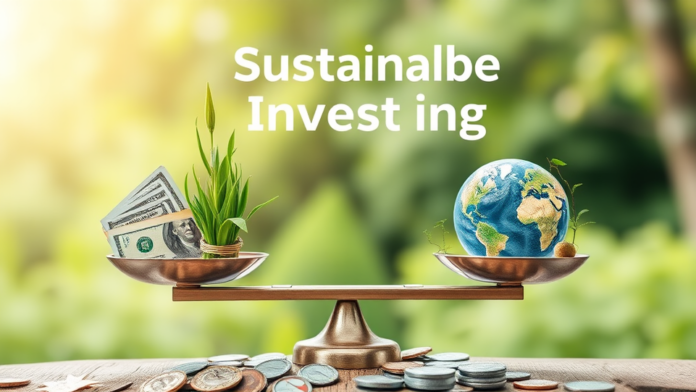Sustainable Investing: Balancing Profits and Environmental Impact
Definition and Importance
Sustainable investing refers to the integration of environmental, social, and governance (ESG) factors into investment decisions. This approach aims to generate long-term financial returns while promoting positive societal impact. Investors increasingly recognize that sustainable practices can mitigate risks and enhance portfolio resilience. It’s essential to understand that these investments often outperform traditional ones. This trend is not just a passing phase; it reflects a fundamental shift in market dynamics. The financial landscape is evolving. Investors should consider this shift seriously.
Historical Context and Evolution
Sustainable investing has evolved significantly since its inception in the 1960s. Initially, it focused on socially responsible investing, primarily excluding industries like tobacco and firearms. Over time, the approach expanded to include comprehensive ESG criteria. This evolution reflects growing awareness of corporate responsibility. Investors now seek to align their portfolios with personal values. The shift is notable in institutional investment strategies. Many funds now incorporate sustainability metrics. This trend is reshaping capital allocation. It’s a pivotal moment in finance.
Understanding Environmental, Social, and Governance (ESG) Criteria
What are ESG Criteria?
ESG criteria encompass three key dimensions: environmental, social, and governance factors. These metrics assess a company’s sustainability practices and ethical impact. Environmental criteria evaluate resource management and pollution control. Social factors consider employee relations and community engagement. Governance examines corporate leadership and transparency. Investors increasingly rely on these criteria to make informed decisions. This attack enhances risk management. It also aligns investments with ethical standards. Understanding ESG is crucial for modern investors. It’s a vital aspect of financial analysis.
How ESG Influences Investment Decisions
ESG factors significantly influence investment decisions by providing a framework for assessing long-term sustainability. Investors analyze these criteria to identify potential risks and opportunities. For instance, companies with strong environmental practices often demonstrate better resource efficiency. This can lead to cost savings and improved profitability. Social responsibility also plays a crucial role; firms that prioritize employee welfare tend to have higher retention rates. Governance structures that promote transparency can enhance investor confidence. These insights guide investors toward more informed choices. It’s essential to consider these factors seriously.
The Financial Performance of Sustainable Investments
Comparative Analysis with Traditional Investments
Sustainable investments often outperform traditional investments in several key areas.
Investors increasingly recognize these advantages. This trend is reshaping investment strategies. It’s a significant shift in finance.
Long-term vs. Short-term Returns
Sustainable investments typically favor long-term returns over short-term gains. This approach aligns with the growing emphasis on corporate responsibility. Investors often find that companies committed to sustainability demonstrate more stable growth. Consequently, these firms can weather market fluctuations better. Short-term returns may appear attractive, but ghey often come with higher risks. Investors should consider the broader impact of their choices. It’s essential to evaluate long-term potential .
Strategies for Sustainable Investing
Positive Screening and Negative Screening
Positive screening involves selecting companies that meet specific sustainability criteria. This strategy focuses on identifying firms with strong environmental and social practices. Investors often prioritize sectors like renewable energy and sustainable agriculture. Negative screening, on the other hand, excludes companies involved in harmful activities. This includes industries such as tobacco, fossil fuels, and weapons manufacturing. Both strategies aim to align investments with ethical values. Investors should carefully evaluate their preferences. It’s a critical aspect of sustainable investing.
Impact Investing and Shareholder Advocacy
Impact investing focuses on generating measurable social and environmental benefits alongside financial returns. This strategy targets sectors like affordable housing and clean energy. Investors actively seek opportunities that create positive change. Shareholder advocacy complements this approach by influencing corporate behavior. Investors engage with companies to promote sustainable practices. This can involve voting on shareholder resolutions or initiating dialogues with management. Both strategies empower investors to drive meaningful impact. It’s a proactive approach to investing.
Challenges in Sustainable Investing
Greenwashing and Misleading Claims
Greenwashing refers to the practice of companies misleading investors about their environmental practices. This can involve exaggerated claims or vague language that obscures actual performance. Investors must be vigilant in identifying these misleading assertions. Many firms may present themselves as sustainable without substantial evidence. This lack of transparency complicates informed decision-making. Investors should conduct thorough due diligence. It’s essential to verify claims with credible data. Awareness is crucial in combating greenwashing.
Market Volatility and Risk Assessment
Market volatility poses significant challenges for sustainable investing. Fluctuations can impact the performance of green assets. Investors must assess risks associated with these investments. This includes evaluating regulatory changes and market sentiment. Additionally, sustainable sectors may experience heightened volatility due to emerging trends. Investors should remain informed about market dynamics. It’s essential to develop a robust risk management strategy. Awareness of these factors is crucial for success.
Future Trends in Sustainable Investing
Technological Innovations and Their Impact
Technological innovations are reshaping sustainable investing significantly. Advancements in data analytics enable more precise ESG assessments. This allows investors to make informed decisions based on real-time information. Additionally, blockchain technology enhances transparency in supply chains. It can verify the sustainability claims of companies. Furthermore, artificial intelligence is streamlining investment processes. These tools improve efficiency and reduce costs. Investors should embrace these innovations. They are crucial for future success.
Regulatory Changes and Global Initiatives
Regulatory changes are increasingly influencing sustainable investing practices. Governments worldwide are implementing stricter ESG disclosure requirements. This enhances transparency and accountability among companies. Additionally, global initiatives like the Paris Agreement drive investment toward sustainable projects. Investors must adapt to these evolving regulations. Compliance is essential for long-term success. Awareness of these changes is crucial. It can impact investment strategies significantly.

